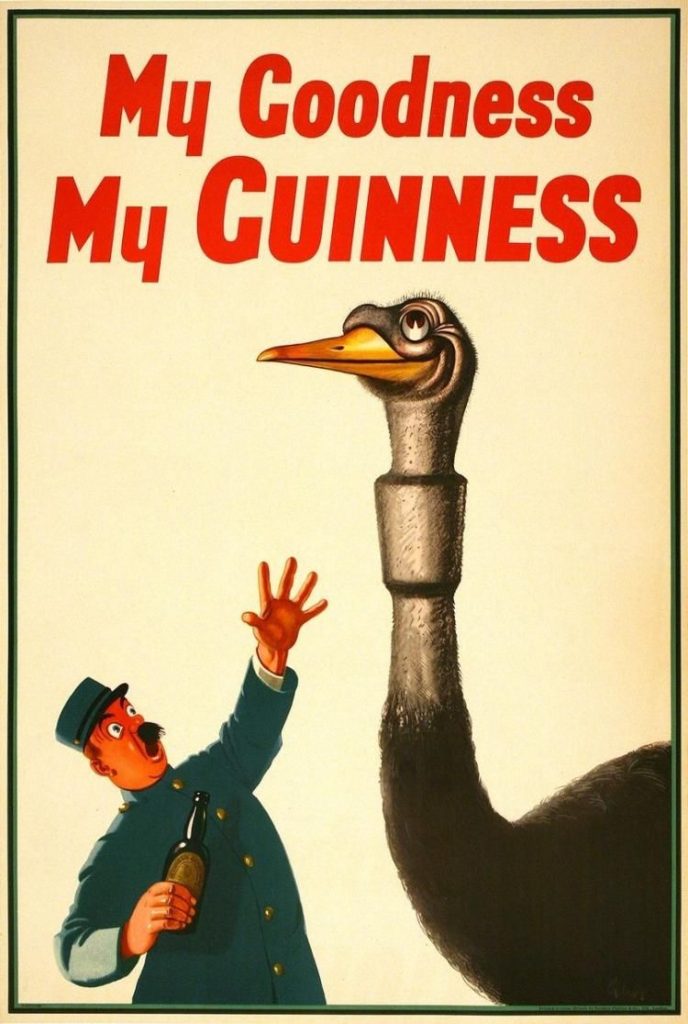Does anyone remember seeing a Guinness Festival Clock? Last year, while researching an item on the bizarre but memorable work of artist Rowland Emett, I came across this bonkers project some had, wrongly, attributed to him.

Originally designed and featured in the Festival of Britain, the Clock was actually the brainchild of the Guinness Advertising Manager Martin Pick, who had trained as an engineer before he entered the world of advertising.
Every quarter of an hour brought a frenzied burst of activity from an assortment of the characters created by the artist John Gilroy to advertise Guinness – the
animals and their zookeeper, accompanied by fairground music. The zookeeper began the sequence by emerging from a tower and ringing a bell.
Following the zookeeper the assortment of other animals would emerge, one after the other, each performing their own set piece and then withdrawing back into the Clock in reverse order.
After approximately five minutes, the sequence was finally brought to a conclusion by the zookeeper once again ringing his bell.
The Clock was designed by the firm of Lewitt Him and took five months for clockmakers Baume and Co Ltd. of Hatton Garden to construct. Standing 25 feet high, the Clock’s internal mechanism was highly elaborate and included nine reversible electric motors and three synchronous clocks.
Since the Clock’s mechanism could easily be affected by wind, it was necessary to have an electrician standing by. He would also be responsible for counting the visitors to the Clock.

Various Guinness Clocks were on display around the country, including one in Morecambe and this video shows it in operation, sadly, with no contemporary sound.
The Clocks were in use for fifteen years until 1966 when they were withdrawn, but an original one-fifth scale model of the clock is on display in the Guinness Storehouse World of Advertising permanent exhibit.
Artist John Gilroy was a polymath of the painting world, with a mind unlike those of his peers. Because of this, the Guinness campaigns he brought to life from 1928 to the 1960s remain as distinctive now as they were back then.
“It was Gilroy’s colourful artwork that moved our advertising forward,” the company notes. “One of the most memorable was born of his creative interpretation of a performing sea lion that caught his eye at the zoo. That animal, Gilroy mused, would be smart enough to balance a glass of Guinness on its nose. This concept became one of the longest living advertising campaigns in history: ‘My Goodness, My Guinness’.”

The hapless zookeeper, a caricature of Gilroy himself, presented the family of unruly animals. From an ostrich swallowing a Guinness, glass and all, to a pelican with a beak full of bottles. A bounding lion, a thieving bear. A crocodile, kangaroo, and penguin. And, of course, most famous of all, the toucan.

This evolved, via the toucan, into the “Guinness-a-day” campaign. That fans still adorn their walls with this poster today is a testament to the creative relationship between Gilroy and Guinness.
With thanks to Andrew Reilly for Morecambe postcards
The founder of downthetubes, which he established in 1998. John works as a comics and magazine editor, writer, and on promotional work for the Lakes International Comic Art Festival. He is currently editor of Star Trek Explorer, published by Titan – his third tour of duty on the title originally titled Star Trek Magazine.
Working in British comics publishing since the 1980s, his credits include editor of titles such as Doctor Who Magazine, Babylon 5 Magazine, and more. He also edited the comics anthology STRIP Magazine and edited several audio comics for ROK Comics. He has also edited several comic collections, including volumes of “Charley’s War” and “Dan Dare”.
He’s the writer of “Pilgrim: Secrets and Lies” for B7 Comics; “Crucible”, a creator-owned project with 2000AD artist Smuzz; and “Death Duty” and “Skow Dogs” with Dave Hailwood.
Categories: Art and Illustration, downthetubes News, Other Worlds
 Kevin O’Neill original “Torquemada”art up for auction
Kevin O’Neill original “Torquemada”art up for auction  Telos Publishing opens orders for The Fantastic Art of Ron Turner
Telos Publishing opens orders for The Fantastic Art of Ron Turner  Chris Foss: A Sci-Fi Journey Exhibition proves a hit for Art for Guernsey Gallery
Chris Foss: A Sci-Fi Journey Exhibition proves a hit for Art for Guernsey Gallery  Prince Valiant Artists illustrators Special #19 Limited Edition announced
Prince Valiant Artists illustrators Special #19 Limited Edition announced
“Bonkers Designs”? How dare you, Sir! British inventiveness at its best. And no worries about promoting a foreign product, either. How come not one British beer maker followed suit? Montague Burton and one of Burton’s brewers could have got together for a madcap combination. “A pint of Bass? Suits you, Sir”.